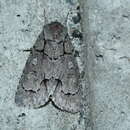Conservation Status
provided by University of Alberta Museums
Uncommon in Alberta, but widespread elsewhere; no concerns.
- license
- cc-by-nc
- copyright
- University of Alberta Museums
Cyclicity
provided by University of Alberta Museums
Adults have been collected in Alberta in June.
- license
- cc-by-nc
- copyright
- University of Alberta Museums
Distribution
provided by University of Alberta Museums
Widespread in eastern and southern North America. In Alberta it has been collected mainly in the southern boreal forest and the more mesic parts of the aspen parklands region, as well in the foothills near Calgary.
- license
- cc-by-nc
- copyright
- University of Alberta Museums
General Description
provided by University of Alberta Museums
"A medium-sized moth (3.6-3.8 cm wingspan) with powdery grey forewings with black markings and dirty white hindwings. There is a prominent black basal streak that extends just through the antemedian line. The antemedian line is oblique, angled distad toward the lower margin, and is doubled and filled with lighter grey scales. The postmedian line curves outward on the upper half, and is crossed by a fine black streak in the anal angle. The orbicular spot is round, light grey and partially outlined in black scales. The reniform is less clearly defined, and is also partially outlined in black scales. The hindwings are dirty white, darkening toward the outer margin. Sexes are similar, with females having more dark scaling on the hindwings.
Very similar to the much commoner Grey Dagger-moth (A. grisea), which is slightly broader-winged and smaller-bodied. The best character for separating radcliffei and grisea is the postmedian line; in radcliffei it runs straight to the margin, whereas in grisea it angles sharply distad and then basad at the lower margin.
"
- license
- cc-by-nc
- copyright
- University of Alberta Museums
Habitat
provided by University of Alberta Museums
Deciduous and mixedwood forest.
- license
- cc-by-nc
- copyright
- University of Alberta Museums
Life Cycle
provided by University of Alberta Museums
A solitary defoliator of hardwood trees or shrubs. The adults are attracted to light. There is a single annual brood, with the adults flying in late spring.
- license
- cc-by-nc
- copyright
- University of Alberta Museums
Trophic Strategy
provided by University of Alberta Museums
No Alberta data; elsewhere in Canada it has been recorded from a variety of deciduous trees and shrubs, with most records from white birch (Betula papyrifera (Prentice, 1962). Rings et al (1992) summarized a number of host records reported in the literature, most in the family Rosacea, including apple (Malus), serviceberry (Amelanchier, and various cherries (Prunus), but also mountain ash (Sorbus), elm (Ulmus, and willow (Salix).
- license
- cc-by-nc
- copyright
- University of Alberta Museums
Acronicta radcliffei
provided by wikipedia EN
Acronicta radcliffei, or Radcliffe's dagger moth, is a moth of the family Noctuidae. The species was first described by Leon F. Harvey in 1875. It is found in eastern and southern North America.
The wingspan is 36–38 mm. Adults are on wing from May to August depending on the location.
Recorded food plants include ash, birch, chokecherry, elm, serviceberry, sour cherry, wild black cherry and willow.
Subspecies
- Acronicta radcliffei radcliffei
- Acronicta radcliffei vancouverensis
Life cycle

- license
- cc-by-sa-3.0
- copyright
- Wikipedia authors and editors
Acronicta radcliffei: Brief Summary
provided by wikipedia EN
Acronicta radcliffei, or Radcliffe's dagger moth, is a moth of the family Noctuidae. The species was first described by Leon F. Harvey in 1875. It is found in eastern and southern North America.
The wingspan is 36–38 mm. Adults are on wing from May to August depending on the location.
Recorded food plants include ash, birch, chokecherry, elm, serviceberry, sour cherry, wild black cherry and willow.
- license
- cc-by-sa-3.0
- copyright
- Wikipedia authors and editors

